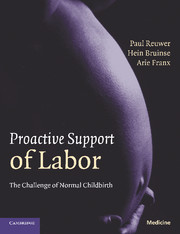Book contents
- Frontmatter
- Contents
- Foreword
- Acknowledgments
- Web-Forum
- 1 General introduction
- Section 1 A wake-up call
- Section 2 Back to basics
- Section 3 Proactive support of labor
- 12 Introductory synopsis
- 13 Nulliparous versus parous labor
- 14 Diagnosis of labor
- 15 Prevention of long labor
- 16 Personal continuity and continuous support
- 17 Amniotomy and oxytocin
- 18 Labor pain in broader perspective
- 19 Prelabor preparation
- 20 Medical pain relief revisited
- 21 Dynamic dystocia unraveled
- 22 Mechanical birth obstruction
- 23 Curtailed use of induction
- 24 Intrapartum care of the fetus
- 25 Prevention of litigation
- 26 Organizational reforms
- 27 Continual audit and feedback
- 28 Quality assessment
- 29 Hospital statistics
- 30 Sum of the parts
- Index
- References
30 - Sum of the parts
Published online by Cambridge University Press: 08 September 2009
- Frontmatter
- Contents
- Foreword
- Acknowledgments
- Web-Forum
- 1 General introduction
- Section 1 A wake-up call
- Section 2 Back to basics
- Section 3 Proactive support of labor
- 12 Introductory synopsis
- 13 Nulliparous versus parous labor
- 14 Diagnosis of labor
- 15 Prevention of long labor
- 16 Personal continuity and continuous support
- 17 Amniotomy and oxytocin
- 18 Labor pain in broader perspective
- 19 Prelabor preparation
- 20 Medical pain relief revisited
- 21 Dynamic dystocia unraveled
- 22 Mechanical birth obstruction
- 23 Curtailed use of induction
- 24 Intrapartum care of the fetus
- 25 Prevention of litigation
- 26 Organizational reforms
- 27 Continual audit and feedback
- 28 Quality assessment
- 29 Hospital statistics
- 30 Sum of the parts
- Index
- References
Summary
Proactive support of labor is an all-embracing concept of birth care, firmly rooted in the basic physiology of birth and strongly supported by clinical evidence for each of its components. Throughout the previous chapters it was constantly emphasized that all ingredients of the program need to be addressed if real progress is to be made. None of them can be ignored. Lessons should be learned from the confusion raised by “active management” programs – mostly deceptively so-called – whereby practice change remained restricted to intensified use of oxytocin while O'Driscoll's other propositions – strict diagnoses, consistent policies, personal attention, organizational reforms, and continuous audit – were virtually ignored (Chapter 12). Predictably, such a stripped version does not work. This final chapter discusses the misunderstandings pervading the literature about “active management,” from which proactive support has been derived, separating the wheat from the chaff.
The interventional component
Doubts have been cast on the value of amniotomy and oxytocin because some controlled trials failed to demonstrate a reduction in cesarean rates (Chapter 17). Although these studies were strictly focused on the subject of augmentation, meta-analyses and editorial comments simply concluded that “the active management of labor” does not work. This is a typical example of how “evidence-based” data may lead to misplaced extrapolations and false conclusions. Desktop scientists questioning the system by focusing on one single part are “like a mechanic trying to decide which component of a car's engine makes it go.”
- Type
- Chapter
- Information
- Proactive Support of LaborThe Challenge of Normal Childbirth, pp. 253 - 258Publisher: Cambridge University PressPrint publication year: 2009



